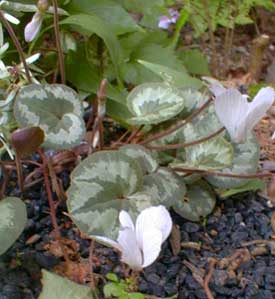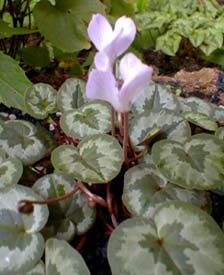
A Miniature
Pattern-leaf Cyclamen
"Would you prefer myrrh-flower or cyclamen?
I have them, I could spread them out again"
-H.D
(Hilda Doolittle,
1886-1961)
(Hilda Doolittle,
1886-1961)
We obtained a second-year seedling of Cyclamen intaminatum for a stiff price from Heronswood Nursery, who get their seeds from the famed English grower, Ashwood.
We really didn't expect to see much of a plant for its first year, but to our amazement our winter planting produced quite a few leaves right away, then in April it started flowering, still flowered through June, & was flowering most intensely in September.
It has a long way to go to become mature & impressive patch, but there certainly was no wait for it to be a darned interesting & pretty little clump. The patch of leaves thickened gorgeously & remained very pleasing all through winter; even a week spent under snow didn't discourage them.
The scentless flowers tend to be white with the faintest grey veining, but some are palest pink. There are select cultivated forms which are slightly darker pink. It self-seeds easily & will spread into a colony unless competition for space from larger plants is too tough for it.
It is smaller than any cyclamen except C. parviflorum. Its smallness makes it a bit harder to establish in the open garden. Even though it's as frost-hardy as its closest relative, C cilicium, it is just too easily overwhelmed due to its dwarf stature, & can be crowded out by even small groundcovers.
 For this reason it is more to be recommended for raised beds or outdoor containers. In our garden, we built a miniature raised bed by laying down a crusty & interesting old iron hoop & filling the hoop with good soil, & planting the miniature cyclamen in its own personal four-inch-high raised bed (along with a miniature fritillary, F. pudica). We laid black pea-gravel over the the surface partly to assist the cyclamen in its need for perfect drainage, but mainly for the look of it.
For this reason it is more to be recommended for raised beds or outdoor containers. In our garden, we built a miniature raised bed by laying down a crusty & interesting old iron hoop & filling the hoop with good soil, & planting the miniature cyclamen in its own personal four-inch-high raised bed (along with a miniature fritillary, F. pudica). We laid black pea-gravel over the the surface partly to assist the cyclamen in its need for perfect drainage, but mainly for the look of it.This western Turkish cyclamen was first described by E. K. Balls in 1934, but was initially believed to be a variant of C. cilicium. It was not recognized as its own species until the late 1980s, & is even more recent as an addition to gardening horticulture.
There are presently a handful of nursery-produced forms that range into slightly darker pinks, & slightly larger leaves, some with plain oval leaves, some with silvered leaves. Those with plain leaves will grow true from seeds, but fancier-leafed specimens are less predictable. Sometimes leaves are flushed pink when young, or have a hint of a rosy tinge at the upper edges.
The one we obtained was the Pattern-Leafed form with very round leaves, silvered with a ragged arrow or pyramid of pure green in the center of each leaf. The leaves of May through Summer showed this pattern only faintly, but the new round leaves of Autumn were intensely marked with their green arrow-pattern or christmas tree silhouette within frosty silver.
Different catalogs say different things about its bloom time. For us in its first year it bloomed spring through autumn, & although too young a plant to be particularly flowery at any given moment, the persistance of both its leaves & its blossoms took us by surprise.
It is capable of blooming continuously until November, according to Ashwood Nursery which is the leading grower of unusual cyclamen species. But Thimble Farms says it blooms February through April, while the most significant book on gardening cyclamens says it blooms September through part of November. I have to assume the difference of opinion is dependent upon zone, but happily for ourselves, it looks like the lengthy Ashwood estimate is the correct one.
Continue to
Cyclamen cilicium